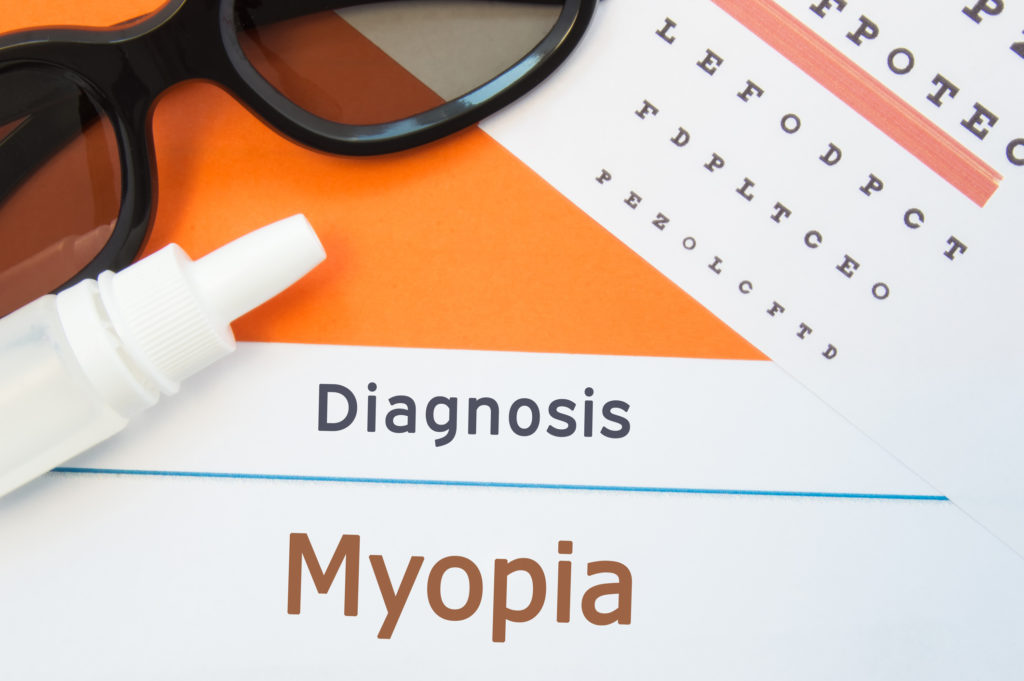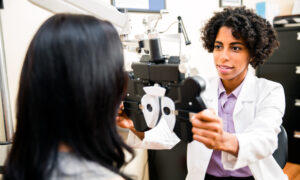By Geetha Sravani
PHD Student, Brien Holden Vision Institute
 The prevalence of myopia and high myopia is increasing globally and across various ethnic groups. In the meta-analysis conducted by Williams et al. (2015)1, 2, the prevalence of myopia and high myopia was found to be 30.6% and 2.7% respectively. Age-specific studies showed a higher prevalence (47.2%) of myopia in the younger (25 to 29 years) age group. In the meta-analysis conducted by Holden et al. 20163, in the year 2000, the prevalence of myopia and high myopia was 1406 million myopes (22.9%) and 163 million high myopes (2.7%), respectively. Lin et.al4 reported prevalence of high myopia was 24% in girls and 18% in boys at the age of 18 years. Few studies showed the association between the near work, parental myopia, genetics and outdoor activities with myopia.
The prevalence of myopia and high myopia is increasing globally and across various ethnic groups. In the meta-analysis conducted by Williams et al. (2015)1, 2, the prevalence of myopia and high myopia was found to be 30.6% and 2.7% respectively. Age-specific studies showed a higher prevalence (47.2%) of myopia in the younger (25 to 29 years) age group. In the meta-analysis conducted by Holden et al. 20163, in the year 2000, the prevalence of myopia and high myopia was 1406 million myopes (22.9%) and 163 million high myopes (2.7%), respectively. Lin et.al4 reported prevalence of high myopia was 24% in girls and 18% in boys at the age of 18 years. Few studies showed the association between the near work, parental myopia, genetics and outdoor activities with myopia.
This article aimed to:
- Identify the factors that influence the age of onset of myopia and progression of myopia that result in adulthood myopia.
- How do differences in the definition of high myopia affect estimates of its prevalence?
Two hundred and forty myopic children with a mean age of 10.9 ±2 years were recruited and randomized control trial of myopia treatment with spectacles: continuous use, distant use only and bifocals with a 1.75 D add were allocated. Three clinical follow-ups one at 3 years interval and the other two at 10 years interval were conducted. The mean age of the subjects at follow-ups two and three were 23.7 (n=179) and 34.7 years (n=134) respectively. Near work, watching television, parental myopia and outdoor activities were assessed using a questionnaire at the clinical follow-ups.
Mean Spherical Equivalent refractive error (SE) at baseline was -1.43D ranging from -0.38D to -3.00D. At the end of the follow up (mean 22±3.9 years), mean SE of the more myopic eye was -5.29 (-1.00D to -11.25 D).
About 32% of children in the age group of 8.8 to 12.8 years who received first spectacles for myopia had high myopia in adulthood. The odds ratio of having high myopia was 3.9 % (95% CI) when both parents were myopic. Younger ages at baseline and higher myopia at baseline also increased the risk of high myopia. Additionally, high myopia was associated with near work. Thus, factors associated with adulthood high myopia were parental myopia, younger age at baseline, higher baseline myopia and greater time spent on near work versus outdoor activities at childhood.
Additionally, the study found that when varying definitions for high myopia were used, the prevalence varied substantially (-5.00D, 52% prevalence; -6.00D, 32%)
Therefore, the authors suggest that an acceptable definition of high myopia is needed.
References
- Williams KM, Verhoeven VJ, Cumberland P, et al. (2015a): Prevalence of refractive error in Europe: the European Eye Epidemiology (E (3)) Consortium. Eur J Epidemiol 30:305–315.
- Williams KM, Bertelsen G, Cumberland P, et al. (2015b): Increasing prevalence of myopia in Europe and the impact of education, Ophthalmology122: 1489–1497.
- Holden BA, Fricke TR, Wilson DA, et al. (2016): Global Prevalence of Myopia and High Myopia and Temporal Trends from 2000 through 2050, Ophthalmology 123:1036–1042.
- Lin LL, Shih YF, Hsiao CK, Chen CJ, Lee LA& Hung PT (2001): Epidemiologic study of the prevalence and severity of myopia among schoolchildren in Taiwan in 2000. J Formos Med Assoc100: 684–891.
Risk factors for high myopia: a 22-year follow-up study from childhood to adulthood.
Pärssinen O, Kauppinen M.
ABSTRACT
PURPOSE: To determine the effect of the definition of high myopia on its prevalence and risk factors for high myopia.
METHODS: A total of 240 myopic schoolchildren (119 boys and 121 girls) at the mean age of 10.9 years (range 8.8-12.8 years) were recruited to a randomized clinical trial of myopia treatment among children from 3rd- and 5th grades of school referred for an eye examination due to poor distant vision and having no previous spectacles. Clinical follow-ups, including refraction with cycloplegia, were conducted annually at 3 years [third follow-up here = clinical follow-up 1, (n = 237)], and thereafter twice at approximately 10-year intervals [clinical follow-ups 2 (n = 179) and 3, (n = 134)]. Additional refraction values between follow-ups 2 and 3 were received from ophthalmologists and opticians’ prescriptions and records. The most recent adulthood refraction measure available was taken as the final refraction value for 204 (85%) of the original cohort [mean follow-up time (±standard deviation) 22.1 (±3.9) years]. Parental myopia, time spent on reading and close work, watching TV and outdoor activities were assessed with a questionnaire at the clinical follow-ups. The influence of different definitions of high myopia on its prevalence was analysed. The associations of different factors with high myopia were investigated.
RESULTS: Mean spherical equivalent (SE) at baseline was -1.43 (±0.60) D, ranging from -0.38 D to -3.00 D. At follow-up end, mean SE of the more myopic eye was -5.29 (±1.95) D, ranging from -1.00 D to -11.25 D. High myopia prevalence with the definitions SE < -6.00 D in the right eye and SE ≤ -6.00 D or ≤-5.00 D in either eye was 24%, 32% and 52%, respectively. In this study, high myopia was defined as spherical equivalent (SE) ≤ -6.00 D in either eye. If both parents were myopic, the odds ratio (OR) of having high myopia was 3.9 (95% CI: 1.5-10.4). Younger age at baseline predicted higher prevalence of high myopia; baseline ages between 8.8 and 9.7 and between 11.9 and 12.8 years gave prevalences 65% and 7%. Higher myopia at baseline, higher myopic progression between the first follow-ups and more time spent on reading and close work as compared with time spent outdoors were associated with high myopia.
CONCLUSION: About 32% of the children receiving first spectacles for myopia between ages of 8.8-12.8 years had high myopia (SE ≤ -6.00 D in either eye) in adulthood. Different definitions of high myopia ranging between -5 D and -6 D lead to large differences in prevalence. A generally accepted definition of high myopia is thus needed. Parental myopia, age at baseline, myopic progression during the first post onset year, and more time spent on reading and close work and less on outdoor activities in childhood were associated with adulthood high myopia.
Pärssinen, O., & Kauppinen, M. (2018). Risk factors for high myopia: a 22-year follow-up study from childhood to adulthood. Acta ophthalmologica.
PMID: 30460746 DOI: 10.1111/aos.13964













